ABSTRACT
Gambia is the smallest country on the African mainland and is one of the poorest. Agriculture contributes about 23.6% of the national Gross Domestic Product, mainly from crop production. Cattle are the most important livestock species and oxen originally provided most of the draught power. In the fifteenth and sixteenth centuries, horses were traded by the Portuguese with local inhabitants for slaves and then used by the latter as cavalry in local wars. In the nineteenth and early twentieth centuries, equines were of little importance. From the mid twentieth century, however, both horses and donkeys rapidly increased in numbers and became the main providers of animal traction for agricultural work and general transport. Trypanosomosis is the main disease but other diseases also constrain the output of equines. Management of the equine resource is poor in terms of nutrition, health and housing. Poor welfare is also a major problem but there are some attempts by a local charity to improve this through provision of basic services and training of farmers and veterinary personnel.
Key words: War horses, animal traction, donkey, horse, trypanosomosis.
The Republic of Gambia, is located in West Africa between latitudes 13 and 14°N and longitudes 13 and 17°W. With a total area of 11,300 km2, it is the smallest country on the African mainland. The country comprises a narrow strip of land 25 to 50 km wide and 475 km long (CIA, 2016). Gambia River runs through the longitudinal length of the country before debouching into the Atlantic Ocean. The unusually small size and idiosyncratic shape of the country are due to territorial compromises arising from 19th-century Anglo-French rivalry in Western Africa. Following almost 200 years as a British colony, Gambia gained its independence in 1965. Some 11.5% of the country is water, the terrain is generally low lying and subject to flooding but with low hills away from the river. The climate is tropical with a hot rainy season lasting from June to November and a cooler drier season extending from November to May. Other than a very short coast line, Gambia is entirely surrounded by Senegal (CIA, 2016).
The human population of Gambia in 2015 was about 1.9 million. The density of 190 people/km2 means Gambia is one of the most densely populated countries in Africa. About 43% of people live in rural areas. The Gross Domestic Product of US$ 851 million equates to less than US$ 500/person/year, placing Gambia high in the ranks of the poorest countries in the world. The economy relies on tourism, agriculture (23.6% of GDP) and remittances. Groundnuts, rice and palm oil are the main crops, fish is harvested from the sea and livestock provide meat, some milk and power for agricultural and transport applications (UNSD, 2015).
This paper is based on extended periods of residence in Gambia by the author and on a review of literature.
Use of horses in the fifteenth to nineteenth centuries
The Gambia River was first explored by Europeans in the mid fifteenth century. In 1456, the Portuguese exchanged items that were of little value in their eyes for gold at Cantor (modern Kontaur) some 250 miles upstream from the river mouth (Gomes, 1937). One African ruler farther to the east was reputed to have a pile of gold (presumably ore) so large that he tied his horse to it (Gomes, 1937). Towards the end of the fifteenth and during the sixteenth centuries, the Portuguese found it profitable to trade horses for gold as well as for slaves. Many of the Portuguese trade horses were bred in the Cape Verde Islands off the Coast of Africa (Elbl, 1991). The Wolof Empire between the Senegal and Gambia rivers as well as the Mali Empire to the east dominated the local area by the use of horse cavalry to carry out very quick raids on local villages in order to capture slaves for working on their plantations or for further trading. This necessitated a regular supply of horses to replace those that very soon died in the harsh environment and from the effects of trypanosomosis (Elbl, 1991; Law, 1980). An indication of the importance of horses can be gauged from their value in the 1450s when one animal was traded for 10 to 15 slaves and a ship carrying ten horses made a profit of 500 to 700% (da Cadamosto, 1937). In the second half of the fifteenth century the local Wolof people had some 8000 cavalry that was much more effective than previously by the adoption of stirrups, thus allowing more freedom to fling spears than was possible when riding bareback (Gomes, 1937). There was also a good supply of horses, generally bigger than Portuguese ones, from Arab sources trading salt and slaves across the Sahara (Law, 1980).
Mungo Park, who travelled extensively along the Gambia River at the end of the eighteenth and beginning of the nineteenth centuries, noted that he was accompanied by 200 horsemen from Kaarta in 1796 (Park, 1799). He noted that the Moors (from what is now Mauritania, 300 km north of Gambia) were very good horsemen. They rode without fear and their saddles with high pommels and cantles (Figure 1) provided a very secure seat. The greatest pride and one of the principal amusements of the Moors was to put their horses to a full gallop and then stop with a sudden jerk so as frequently to bring the animal down on his haunches. Important people never walked (except when going to pray) and always, even at night, kept two or three horses ready saddled close to the tent. A very high value was placed on their horses as it was by superior fleetness that they were able to make predatory excursions to capture slaves. Horses were fed three or four times a day and generally with fresh milk in the evening (Park, 1799).
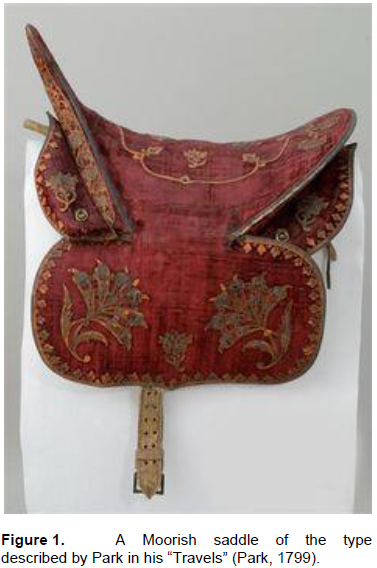
The Moorish cavalry were well mounted and very expert in skirmishing and attacking by surprise. Each soldier provided his own horse and accoutrements that comprised a large sabre, a double-barrelled gun, a small red leather bag for holding his balls and a powder bag. He was not paid and his remuneration arose from plunder. The horses were very beautiful and so highly esteemed that a native prince would pay from twelve to fourteen slaves for one horse (Park, 1799).
Donkeys were not only important to Park (1799) but also in the local economy. Park started his journey with one horse and two donkeys. Over several months donkeys were lost, stolen or confiscated and he generally had problems with them. On one occasion he bought a small but very hardy and spirited horse, which cost the value of £710s, and two asses for his interpreter and servant. Several references were made to the stubborn nature of the donkey. On one such, a very refractory donkey was subject to “a curious method to make him tractable”. A forked stick had the forked part placed in the mouth, like the bit of a bridle, with the two wings tied together above the head leaving the lower part of the stick to strike against the ground should the ass attempt to put his head down. Consequent on this the ass walked quietly and gravely enough, taking care after some practice to hold his head sufficiently high to prevent stones or tree roots from striking the end of the stick, which experience had taught him would give a severe shock to his teeth. Getting horses across a stream was relatively simple. The ferryman held the steadiest by a rope, led it into the water and paddled the canoe out upon which the others, being pelted and kicked on all sides, unanimously plunged into the river and followed their mate. It was more difficult with asses as their disposition made them endure much pelting and shoving before they ventured into the water and often on reaching mid-stream, some would turn back in spite of every exertion to get them forwards. Local people usually travelled on foot, driving their asses before them. Caravans were taxed by local worthies according to the number of loaded asses in them. Donkey loads were very varied including local produce, salt and ivory. In the last case, the larger tusks were carried in nets, two on each side of the animal, whereas smaller ones were wrapped in skins and secured with ropes (Park, 1799).
HORSES AND DONKEYS IN THE TWENTIETH AND TWENTY-FIRST CENTURIES
Numbers
The 1909 livestock census carried out by the colonial authorities reported national populations of over 1,500 horses and 4,000 donkeys (Colonial Secretary, 1909). There do not appear to be any other data on numbers until 1961.
Cattle are important not only for meat production but also for providing draught power in support of crop operations: numbers increased from about 150000 in 1961 to 432000 in 2009 and then fell to 380000 in 2013. Goat numbers were 98000 in 1961, rose to 380000 in 2009 and then fell to 320000 in 2013. A total of 80000 were in the country in 1961, this number rising in a fluctuating manner to 251000 in 2010 and then falling to 150000 in 2013 (FAO, 2014). As Gambia is a Muslim country (it became formally an Islamic Republic in 2015) pigs are of lesser importance with only 3000 head in 1961, rising to 28000 in 2010 and then reducing to 7000 in 2013. There were 190000 domestic fowl in 1961 which through a generally steady increment rose to 1.3 million birds in 2013: ducks and Guinea fowl are very minor poultry species (FAO, 2014).
Donkey numbers increased steadily from 3000 in 1961 to 45000 in 1985, then levelled off until about 2008 when there was a surge in the population to 60000 in 2013. Horses numbered 1000 in 1961, rose to 17000 in 1996 then levelled through to 2003 before, as for donkeys, undergoing a massive upsurge to 41000 in 2008 followed by an unexplained decline to 20000 in 2013 (Figure 2) (FAO, 2014).
In 1987 some 23% of ‘dabada’ reported having horses with 52% having donkeys. Average horse numbers per owning ‘dabada’ ranged from 1.0 to 1.8 in different parts of the country whereas the number of donkeys ranged from 1.4 to 2.2 (Sowe et al, 1988). Sex ratios (male:female) were about 1.0:1.0 for horses and 1.0:1.1 for donkeys. Foaling rates for each species are about 25% per year. Heavy mortality in both species indicates that increases in numbers are from imports from Senegal as, based on vital parameters, the national population is not self-sustaining (Sowe et al., 1988).
Draught and transport
Draught animal power is critical to increased productivity of land and labour and therefore to sustainable agricultural production in the low input systems of Gambia. Equines, donkeys and horses combined, constitute 74% of the draught animal population in Gambia with the remaining 26% being oxen. There is a growing trend of horses and donkeys being increasingly used in areas to the south of their traditional area of use. This will lead to major changes in the subhumid zones mixed crop-livestock production systems (ITC, n.d.).
Gambia began promoting animal traction in the 1950s in order to increase crop production by small-scale farmers. By the mid 1980s, some 63% of farming units used some form of animal traction. Farmers often had difficulty in purchasing a pair of oxen, however, and the number used for draught has remained largely static over many years. Until the beginning of the 1990s, the use of donkeys for animal traction increased rapidly because of the low cost, the availability of light implements developed in Senegal and the advantage of using a single donkey to perform many of the necessary farm operations (Sowe et al., 1988; Sumberg and Gilbert, 1988).
In a 1990 sample of 2411 ‘dabada’ on the North Bank of the river, some 71.4% used animal traction with 41.2% of these using cattle, 55.4% donkeys and 32.3% horses. Cattle were invariably used in pairs whereas equines were usually used singly. Only 9% of ‘dabada’ employing cattle for draught used cows whereas 32% used female donkeys and 29% used female horses (Sowe and Reed, 1993). In neighbouring Senegal, equines are preferred to cattle for draught work not only because only one animal is used but also because they work at a faster speed (Dugué and Dongmo, 2004) and it seems likely that this is also the Gambian philosophy.
Both species are used in crop operations including land preparation with a tiller (Figure 3), planting whereby a seedbox is attached to a tiller (Figure 4), weeding and carting the crop and its by-products from field to farm. Donkeys need a second person, usually a child or a woman, to lead them whereas horses are controlled by one person using a long rein. Harness comprises a breast band of local, usually inappropriate manufacture and material, and rope traces from the breastband to the implement.
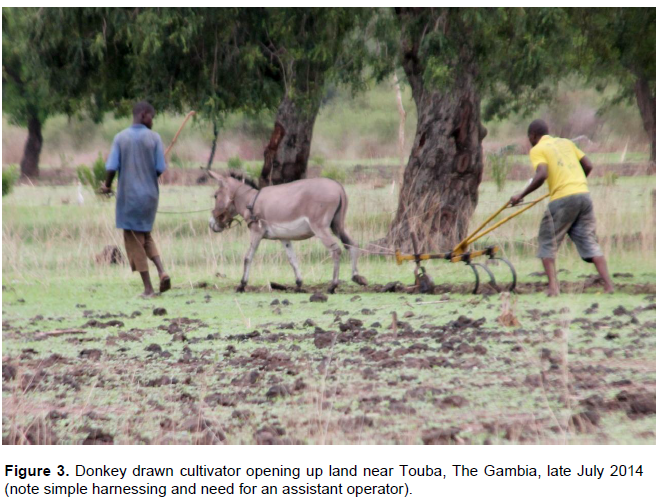
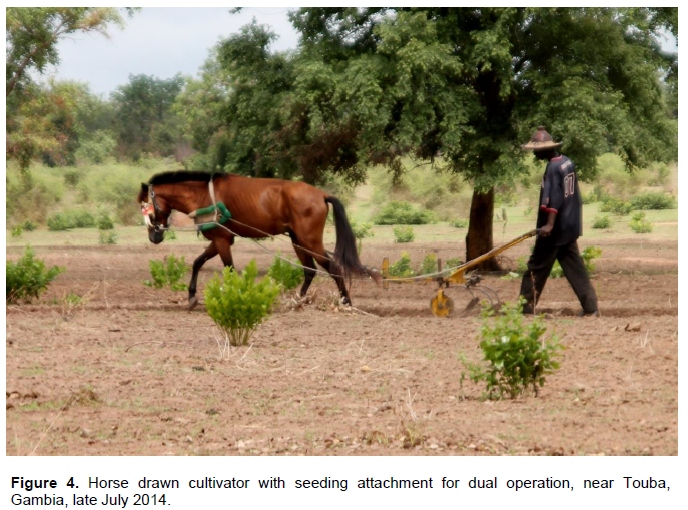
In addition to field and farm work both species of equine are widely used in general rural and urban transport operations. In this role, they usually pull a 2-wheel cart (Figures 5 and 6) and carry a variety of goods and also act as taxis in the transport of people. Once again the harness is less than satisfactory although it does include a breeching strap which is unusual in the African context. Less commonly both species are used as pack animals (Personal observation). A new and albeit limited use of horses is to provide rides for tourists on the beaches south of the capital of Banjul (Figure 7). The saddle and bridle in this context are of the standard English type.
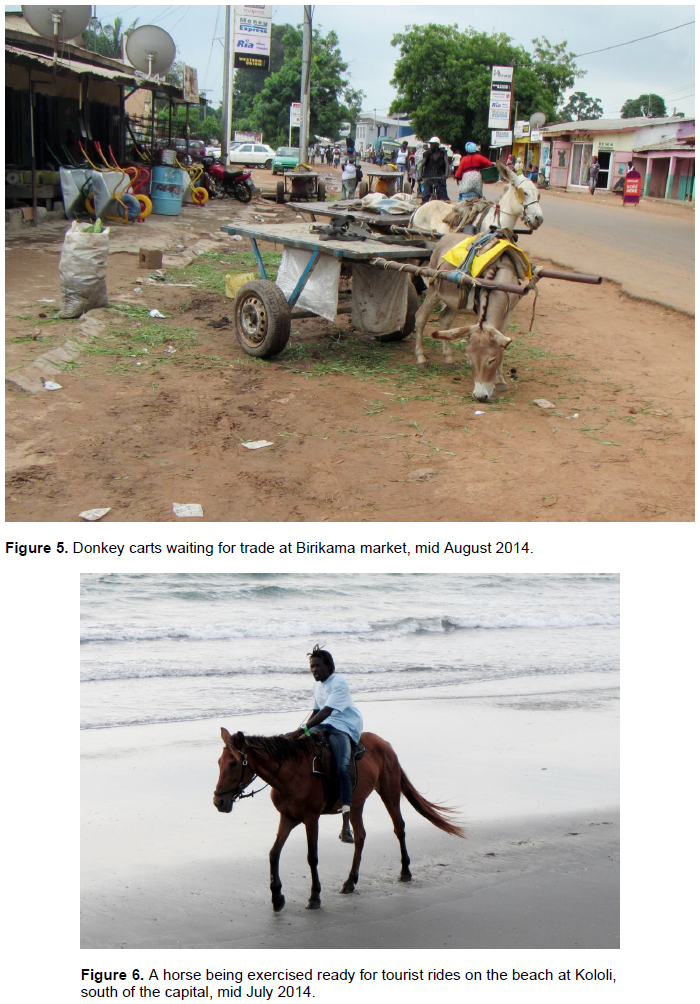
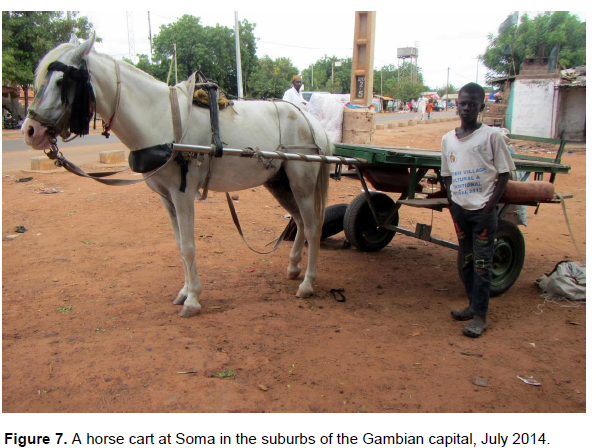
Gastrointestinal and external parasites are a major constraint to the performance of equines. In one study in a sample of 173 donkeys it was found that 83.2% of the animals were hosts to internal parasites. Principal among these were strongyles (81.5% infection), Parascaris species (9.2%), Strongyloides species (4.0%), and Oxyuris species (0.6% (Mattioli et al., 1993). Cases of rectal prolapse caused by massive infections of horse bot fly (Gasterophilus species) larvae have been recorded (GHDT, 2014). Other species of Oestridae and Tabanidae are also a nuisance due to blood sucking and general disturbance.
Tsetse fly is the vector of trypanosomosis. In the past the presence of tsetse was the major inhibitor of the equine population in Gambia (Mattioli et al., 1993). Habitat destruction (clearing for cultivation and wood cutting for fuel) coupled to many years of low rainfall have rendered the environment less suitable for tsetse and resulted in a reduced trypanosome challenge for equines (Mattioli et al., 1993). The use of prophylactics and curative treatments for trypanosome infections, although expensive, has also assisted the increase in equine populations in the country. In one study of 173 donkeys, 9.2% were diagnosed positive for trypanosome infections: T. congolense was the most prevalent parasite, followed by T. brucei and then T. vivax (Mattioli et al., 1993). In a more recent study using different techniques for parasite detection, 91% of 183 horses and 58 donkeys were found to be infected. For individual species 31% were infected with T. congolense, 87% with T. vivax and 18% with T. brucei with multiple species present in 43% of cases (Pinchbeck et al., 2008). The three species of trypanosome were also found in another study comprising 11 horses and 67 donkeys in which it was also shown that, when exposed to a similar tsetse challenge donkeys are significantly less infected than horses (Faye et al., 2001). A retrospective study of 2113 horse and 172 donkey consultation records at a clinic for the period 1995 to 2002 at Sololo in the centre of the country was undertaken. “Trypanosome infection” accounted for 61% of all cases. Trypanosome infections were recorded in 63% of horses compared to 43% in donkeys. In both species infections were mainly due to T. congolense (64%) and T. vivax (32%). No differences were seen in the occurrence of infections in male or female donkeys but more female (67.8%) than male (60.7%) horses were infected. There were no differences in age infections in donkeys but more older (63.2% >1 year) than younger horses (54.5%<1 year) were infected. In both species, infection rates decreased during the rainy season of June-September. The results, based on farmer questioning, also showed they had a fairly accurate knowledge of the diseases affecting their equines (Dhollander et al., 2006).
Nearly all Gambian equines are reportedly seropositive to African Horse Sickness Virus (AHSV) (Mattioli et al., 1992; Oura et al., 2012). In a light trap study, species of Culicoides known or suspected as vectors of African horse sickness virus (AHSV) and bluetongue virus (BTV) comprised 83% of female captures with 65% being C. imicola or C. miombo. It is suggested that virus challenge from Culicoides vectors may be a factor in the health of Gambian horses and donkeys (Rawlings et al., 1998).
Several other diseases have been reported in Gambian equines and there are undoubtedly others waiting to be recorded. Equine Infectious Anaemia (EIA), caused by a virus and transmitted mechanically by biting flies has been demonstrated in the serum of horses and donkeys in Gambia (Mattioli et al., 1992). Epizootic lymphangitis, a fungal disease due to Histoplasma farciminosum, is reported regularly from the country’s veterinary clinics. An outbreak of strangles (Streptococcus equi) occurred in January 2014 in the donkey population of Sambel Kunda and surrounding villages which spread to the donkey herd of the Gambia Horse and Donkey Trust (GHDT, 2014). Pythium insidiosum, an oomycete pathogenic in mammals occurs mainly in tropical and subtropical areas and particularly in horses, dogs and humans (Gaastra et al., 2010). One case was recorded in a horse in Gambia in February 2013 (GHDT, 2014). Babesiosis, known in horses and donkeys as Equine Piroplasmosis (EP), is usually caused by Babesia caballi or Theileria equi (formerly Babesia equi) or occasionally by both. It was searched for in a special study but no evidence of either species was found (Mellhuish, 2011).
Welfare
In one of the poorest countries in the world and with many people chronically hungry it is no surprise that animal welfare is not a primary concern. Coupled to this are the relatively recent introduction of equines as work animals and the lack of knowledge of owners about their charges. Symptoms of disease are not recognized, physical deformities are ignored and animals are often chronically malnourished. Concurrent to these “passive” problems are “active” ones of physical cruelty to animals including beating with sticks and clubs and attacks by their owners with sharp weapons.
The Gambian Horse and Donkey Trust (GHDT), established in 2002, is a charity working with owners to pioneer good husbandry and healthcare (Figure 8). It provides harness and equipment, undertakes farriery, performs dentistry and provides veterinary treatment at low cost. It also provides theoretical and practical training courses to owners and users in an attempt to educate them to be more conscient of animal needs and to provide better care for them. GHDT also supports training courses for government animal health assistants at the local veterinary school. There is no doubt that the trust has had a positive impact on the welfare of equines in the area in which it works. It should be understood, however, that it has limited funding and few personnel and its physical area of outreach is limited. There remains much to be done for the welfare of Gambia’s equines.
Equines, particularly donkeys, have increased in popularity since the 1950s. It has been concluded (Starkey, 1986) that "during the period 1965 to 1985, donkeys changed from being of minor importance to their present status as the dominant draft animal in Gambia". The extent and rapidity of this change is illustrated as in a broad but detailed study of Gambian agriculture in 1972 to 1975 emphasis was placed on ox cultivation but there was only passing reference to equines (Dunsmore et al., 1976).
A number of widespread beliefs continue to exist about equines in Gambia. This "perceived wisdom" can be summarized as: in the past the use of equines was limited by trypanosomosis; horses and donkeys were relatively inexpensive and were not expected to survive over long periods, and low reproductive rates were the norm. The tsetse challenge undoubtedly declined in the second half of the twentieth century and continues to do so but it is believed that large numbers of equines are still imported from neighbouring countries and account in large part for the maintenance and increase of the Gambian resident populations. The predominance of males, older ages and physical condition of imported animals contributes to the poor reproductive performance and high mortality of the country's horses and donkeys. Management factors, however, are of equal or greater importance than the foregoing, including nutrition, work time, housing and health care.
The advantages of equines over oxen as work animals are multiple. They, and especially horses, work at a greater speed, can be used singly and work longer spells than oxen. In addition to the management factors to which allusion has already been made, equine performance could be greatly improved by provision of better harness. A clear example would be the replacement of the breastband with a collar. With the former the animal “pulls” its attachment as it works through its forelimbs only whereas with a collar the horse or donkey can use its hindlimbs to apply its force as it “pushes” the implement. Horses with collars can apply 50% more power to a task in a given time period than those with breastbands (Riddle, 2008). A major disadvantage of equines in comparison with oxen is that when retired from work they cannot be eaten (in the Gambian context) as cattle can (Sowe and Reed, 1993).
The author has no financial or personal relationships that could inappropriately influence or bias this paper.
REFERENCES
|
CIA (2016). The Gambia: The World Factbook. Central Intelligence Agency, Washington, DC.
|
|
|
|
Colonial Secretary (1909). Correspondence of the Colonial Secretary, Reference Nos. 2/140 2/143. Gambian National Archives, Banjul, The Gambia.
|
|
|
|
|
da Cadamosto A (1937). The Voyage of Cadamosto. p. 68. In: The Voyages of Cadamosto and Other Documents in Western Africa in the Second Half of the Fifteenth Century. (Crone GR ed.), Hakluyt Society, London.
|
|
|
|
|
Dhollander S, Jallow A, Mbodge K, Kora S, Sanneh M, Gaye M, Bos J, Leak S, Berkvens D, Geerts S (2006). Equine Trypanosomosis in the Central River Division of The Gambia: a Study of Veterinary Gate-clinic Consultation Records. Prev. Vet. Med. 75:152-162.
Crossref
|
|
|
|
|
Dugué P, Dongmo AL (2004). Traction animale et association agriculture élevage dans les savanes d'Afrique de l'ouest et du centre. D'un modèle techniciste à une démarche d'intégration raisonnée à différentes échelles. [Animal draught power and the linkage between agriculture and livestock in the West and Central African savannas: from a technical approach to the beginnings of rational integration at various levels]. Rev. Elev. Méd. Vét. Pays Trop. 57:157-165.
|
|
|
|
|
Dunsmore JR, Blair RA, Lowe GDN, Moffat DJ, Anderson IP, Williams JB (1976). The Agricultural Development of The Gambia: An Agricultural, Environmental and Socioeconomic Analysis. Land Resources Study 22. Land Resources Division -- Overseas Development Administration, London, UK.
|
|
|
|
|
Elbl I (1991). The Horse in Fifteenth Century Senegambia. Int. J. Afr. Hist. Stud. 24:85-110.
Crossref
|
|
|
|
|
FAO (2014). Statistical Yearbook, 2014. Food and Agriculture Organization, Rome.
|
|
|
|
|
Faye D, Pereira de Almeida PJL, Goossens B, Osaer S, Ndao B, Berkvens D, Speybroeck N, Nieberding F, Geerts S (2001). Prevalence and Incidence of Trypanosomosis in Horses and Donkeys in The Gambia. Vet. Parasitol. 101:101-114.
Crossref
|
|
|
|
|
Gaastra W, Lipman LJ, De Cock AW, Exel TK, Pegge RB, Scheurwater J, Vilela R, Mendoza L (2010). Pythium insidiosum: An Overview. Vet. Microbiol. 146:1-16.
Crossref
|
|
|
|
|
GHDT (2014). Cases from The Gambia Horse and Donkey Trust, Dec'13 - May'14. Gambia Horse and Donkey Trust, Banjul, The Gambia.
|
|
|
|
|
Gomes D (1937). The Voyages of Diogo Gomes. In: The Voyages of Cadamosto and Other Documents in Western Africa in the Second Half of the Fifteenth Century. (Crone GR ed.), Hakluyt Society, London. pp 99-101.
|
|
|
|
|
ITC (n.d.). R & D; Draught Animal Power. International Trypanotolerance Centre, Banjul, The Gambia.
|
|
|
|
|
Law R (1980). The Horse in West Africa: The Role of the Horse in the Societies of Pre-colonial West Africa. Oxford University Press, Oxford. pp. 52-53.
|
|
|
|
|
Mattioli RC, Zinsstag J, Pfister K (1992). African Horse Sickness and Equine Infectious Anaemia Serology in The Gambia. Trop. Anim. Health Prod. 24:207-208.
Crossref
|
|
|
|
|
Mattioli RC, Zinsstag J, Pfister K (1993). Frequency of Trypanosomosis and Gastrointestinal Parasites in Draught Donkeys in The Gambia in Relation to Animal Husbandry. Trop. Anim. Health Prod. 26:102-108.
Crossref
|
|
|
|
|
Mellhuish J (2011). Investigating Babesiosis in Working Equids of The Gambia. Royal Veterinary College, London (Mimeo).
|
|
|
|
|
Oura CA, Ivens PA, Bachanek-Bankowska K, Bin-Tarif A, Jallow DB, Sailleau C, Maan S, Mertens PC, Batten CA (2012). African horse sickness in The Gambia: circulation of a live-attenuated vaccine-derived strain. Epidemiol. Infect. 140:462-465.
Crossref
|
|
|
|
|
Park M (1799). Travels in the interior districts of Africa. Performed under the direction and patronage of the African Association, in the years 1795, 1796 and 1797 with an Appendix containing geographical illustrations of Africa by Major Rennell. Bulmer & Co, Ltd, London.
|
|
|
|
|
Pinchbeck GL, Morrison LJ, Tait A, Langford J, Meehan L, Jallow S, Jallow J, Jallow A, Christley R. M (2008). Trypanosomosis in The Gambia: prevalence in working horses and donkeys detected by whole genome amplification and PCR, and evidence for interactions between trypanosome species. BMC Vet. Res. 20(4):7.
Crossref
|
|
|
|
|
Rawlings P, Snow WF, Boorman J, Denison E, Hamblin C, Mellor PS (1998). Culicoides in Relation to Transmission of African Horse Sickness Virus in The Gambia. Med. Vet. Entomol. 12:155-159.
Crossref
|
|
|
|
|
Riddle JM (2008). A History of the Middle Ages, 300-1500. Rowman & Littlefield, London.
|
|
|
|
|
Sowe JM, Reed JD (1993). The Extent of Draught Cow Use in the North Bank Division of The Gambia. In: Recherche Pour Le Développement de la Traction Animale en Afrique de L'Ouest. (Lawrence P, Lawrence K, Dijkman J, Starkey PH eds.). West Africa Animal Traction Network, International Livestock Research Institute, Nairobi, Kenya. pp. 273-275.
|
|
|
|
|
Sowe J, Gai B, Sumberg J, Gilbert E (1988). Foaling and mortality of equines in The Gambia: a national survey. In: Animal Traction for Agricultural Development. (Starkey P, Faye A eds.), Technical Centre for Agricultural and Rural Cooperation, Wageningen, The Netherlands. pp. 315-323.
|
|
|
|
|
Starkey P (1986). Strengthening Animal Traction Research and Development in The Gambia through Networking. Consultancy Report 12. Gambian Agricultural Research and Diversification Project - Ministry of Agriculture, Banjul, The Gambia.
|
|
|
|
|
Sumberg J, Gilbert E (1988). Draft Animals and Crop Production in The Gambia. Department of Livestock Services, Banjul, The Gambia.
|
|
|
|
|
UNSD (2015). World Statistics Pocketbook. United Nations Statistics Division, New York.
|
|






